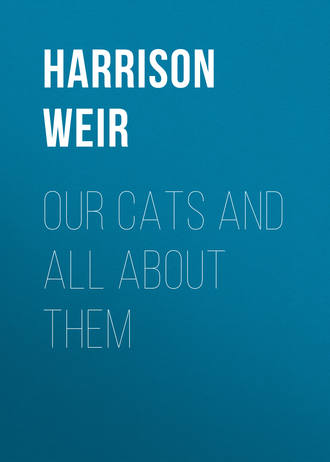 полная версия
полная версияOur Cats and All About Them
As may have been gathered from the foregoing remarks, the points of the tortoiseshell he-cat are, black-red and yellow in patches, but no white. The colouring should be in broad, well-defined blotches and solid in colour, not mealy or tabby-like in the marking, but clear, sharp, and distinct, and the richer and deeper the colours the better. When this is so the animal presents a very handsome appearance. The eyes should be orange, the tail long and thick towards the base, the form slim, graceful, and elegant, and not too short on the leg, to which this breed has a tendency. Coming then to the actual tortoiseshell he, or male cat without white, I have never seen but one at the Shows, and that was exhibited by Mr. Smith. It does not appear that Mr. Smith bred any from it, nor do I know whether he took any precautions to do so; but if not, I am still of the opinion that more might have been produced. In Cassell's "Natural History," it is stated that the tortoiseshell cat is quite common in Egypt and in the south of Europe. This I can readily believe, as I think that it comes from a different stock than the usual short-haired cat, the texture of the hair being different, the form of tail also. I should much like to know whether in that country, where the variety is so common, there exists any number of tortoiseshell he-cats. In England the he-kittens are almost invariably red-tabby or red-tabby-and-white; the red-tabby she-cats are almost as scarce as tortoiseshell-and-white he-cats. Yet if red-tabby she-cats can be produced, I am of opinion that tortoiseshell he-cats could also. I had one of the former, a great beauty, and hoped to perpetuate the breed, but it unfortunately fell a victim to wires set by poachers for game. Again returning to the tortoiseshell, I have noted that, in drawings made by the Japanese, the cats are always of this colour; that being so, it leads one to suppose that in that country tortoiseshell he-cats must be plentiful. Though the drawings are strong evidence, they are not absolute proof. I have asked several travelling friends questions as regards the Japanese cats, but in no case have I found them to have taken sufficient notice for their testimony to be anything else than worthless. I shall be very thankful for any information on this subject, for to myself, and doubtless also to many others, it is exceedingly interesting. Any one wishing to breed rich brown tabbies, should use a tortoiseshell she-cat with a very brown and black-banded he-cat. They are not so good from the spotted tabby, often producing merely tortoiseshell tabbies instead of brown tabbies, or true tortoiseshells. My remarks as to the colouring of the tortoiseshell he-cat are equally applicable to the she-cat, which should not have any white. Of the tortoiseshell-and-white hereafter.
To breed tortoiseshell he-cats, I should use males of a whole colour, such as either white, black, or blue; and on no account any tabby, no matter the colour. What is wanted is patches of colour, not tiny streaks or spots; and I feel certain that, for those who persevere, there will be successful results.
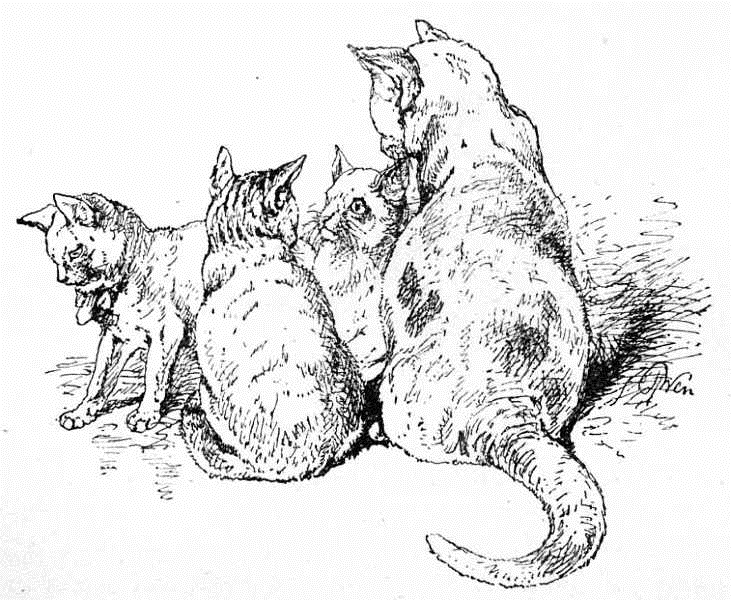
THE TORTOISESHELL-AND-WHITE CAT
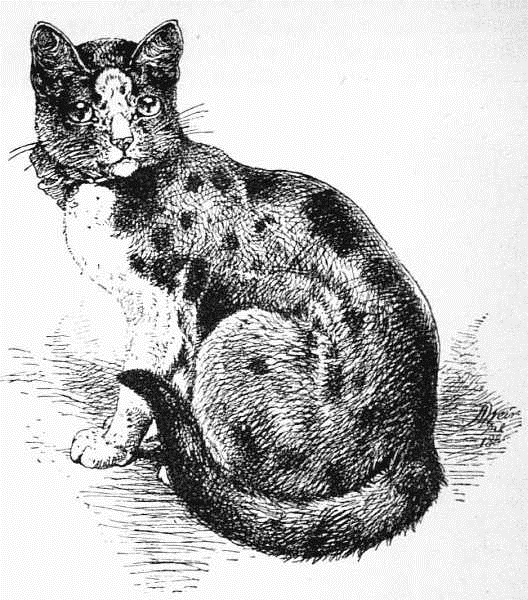
This is a more common mixture of colouring than the tortoiseshell pure and simple without white, and seems to be widely spread over different parts of the world. It is the opinion of some that this colour and the pure tortoiseshell is the original domestic cat, and that the other varieties of marking and colours are but deviations produced by crossing with wild varieties. My brother, John Jenner Weir, F.L.S., F.Z.S., holds somewhat to this opinion; but, to me, it is rather difficult to arrive at this conclusion. In fact, I can scarcely realise the ground on which the theory is based—at the same time, I do not mean to ignore it entirely. And yet, if this be so, from what starting-point was the original domestic cat derived, and by what means were the rich and varied markings obtained? I am fully aware that by selection cats with large patches of colour may be obtained; still, there remain the peculiar markings of the tortoiseshell. Nor is this by any means an uncommon colour, not only in this country, but in many others, and there also appears to be a peculiar fixedness of this, especially in the female, but why it is not so in the male I am at a loss to understand, the males almost invariably coming either red-tabby or red-tabby-and-white. One would suppose that black or white would be equally likely; but, as far as my observations take me, this is not so, though I have seen both pure white, yellow, red, and black in litters of kittens, but this might be different were the he parent tortoiseshell.
Some years ago I was out with a shooting party not far from Snowdon, in Wales, when turning past a large rock I came on a sheltered nook, and there in a nest made of dry grasses laid six tortoiseshell-and-white kittens about eight to ten days old. I was much surprised at this, as I did not know of any house near, therefore these must have been the offspring of some cat or cats that were leading a roving or wild life, and yet it had no effect as to the deviation of the colour. I left them there, and without observing the sex. I was afterwards sorry, as it is just possible, though scarcely probable, that one or more of the six, being all of the same colour, might have proved to be a male. As I left the neighbourhood a few days after I saw no more of them, nor have I since heard of any being there; so conclude they in some way were destroyed.
I have observed in the breed of tortoiseshell or tortoise-shell-and-white that the hair is of a coarser texture than the ordinary domestic cat, and that the tail is generally thicker, especially at the base, though some few are thin-tailed; yet I prefer the thick and tapering form. Some are very much so, and of a good length; the legs are generally somewhat short; I do not ever remember seeing a really long-legged tortoiseshell, though when this is so if not too long it adds much to its grace of action. I give a drawing of what I consider to be a GOOD tortoiseshell-and-white tom or he-cat. It will be observed that there is more white on the chest, belly, and hind legs than is allowable in the black-and-white cat. This I deem necessary for artistic beauty, when the colour is laid on in patches, although it should be even, clear, and distinct in its outline; the larger space of white adds brilliancy to the red, yellow, and black colouring. The face is one of the parts which should have some uniformity of colour, and yet not so, but a mere balancing of colour; that is to say, that there should be a relief in black, with the yellow and red on each side, and so in the body and tail. The nose should be white, the eyes orange, and the whole colouring rich and varied without the least Tabbyness, either brown or gray or an approach to it, such being highly detrimental to its beauty.
I have received a welcome letter from Mr. Herbert Young, of James Street, Harrogate, informing me of the existence of what is said to be a tortoiseshell tom or he-cat somewhere in Yorkshire, and the price is fifty guineas; but he, unfortunately, has forgotten the exact address. He also kindly favours me with the further information of a tortoiseshell-and-white he-cat. He describes it as "splendid," and "extra good in colour," and it is at present in the vicinity of Harrogate. And still further, Mr. Herbert Young says, "I am breeding from a dark colour cat and two tortoiseshell females," and he hopes, by careful selection, to succeed in "breeding the other colour out." This, I deem, is by no means an unlikely thing to happen, and, by careful management, may not take very long to accomplish; but much depends on the ancestry, or rather the pedigree of both sides. I for one most heartily wish Mr. Herbert Young success, and it will be most gratifying should he arrive at the height of his expectations. Failing the producing of the desired colour in the he-cats by the legitimate method of tortoiseshell with tortoiseshell, I would advise the trial of some whole colours, such as solid black and white. This may prove a better way than the other, as we pigeon fanciers go an apparently roundabout way often to obtain what we want to attain in colour, and yet there is almost a certainty in the method.
As regards the tortoiseshell cat, there is a distinct variety known to us cat fanciers as the tortoiseshell-tabby. This must not be confounded with the true variety, as it consists only of a variegation in colour of the yellow, the red, and the dark tabby, and is more in lines than patches, or patches of lines or spots. These are by no means ugly, and a well-marked, richly-coloured specimen is really very handsome. They may also be intermixed with white, and should be marked the same as the true tortoiseshell; but in competition with the real tortoiseshell they would stand no chance whatever, and ought in my opinion to be disqualified as being wrong class, and be put in that for "any other colour."

MRS. VYVYAN'S ROYAL CAT OF SIAM.

BROWN TABBY—BARS THE RIGHT WIDTH.
THE BROWN TABBY CAT
The tabby cat is doubtless one of, if not the most common of colours, and numbers many almost endless varieties of both tint and markings. Of these those with very broad bands of black, or narrow bands of black, on nearly a black ground, are usually called black tabby, and if the bands are divided into spots instead of being in continuous lines, then it is a spotted black tabby; but I purpose in this paper to deal mostly with the brown tabby—that is to say, a tabby, whose ground colour is of a very rich, orangey, dark brown ground, without any white, and that is evenly, proportionably, and not too broadly but elegantly marked on the face, head, breast, sides, back, belly, legs, and tail with bands of solid, deep, shining black. The front part of the head or face and legs, breast, and belly should have a more rich red orange tint than the back, but which should be nearly if not equal in depth of colour, though somewhat browner; the markings should be graceful in curve, sharply, well, and clearly defined, with fine deep black edges, so that the brown and black are clear and distinct the one from the other, not blurred in any way. The banded tabby should not be spotted in any way, excepting those few that nearly always occur on the face and sometimes on the fore-legs. The clearer, redder, and brighter the brown the better. The nose should be deep red, bordered with black; the eyes an orange colour, slightly diffused with green; in form the head should not be large, nor too wide, being rather longer than broad, so as not to give too round or clumsy an appearance; ears not large nor small, but of moderate size, and of good form; legs medium length, rather long than short, so as not to lose grace of action; body long, narrow, and deep towards the fore part. Tail long, and gradually tapering towards the point; feet round, with black claws, and black pads; yellowish-white around the black lips and brown whiskers are allowable, but orange-tinted are far preferable, and pure white should disqualify. A cat of this description is now somewhat rare. What are generally shown as brown tabbies are not sufficiently orange-brown, but mostly of a dark, brownish-gray. This is simply the ordinary tabby, and not the brown tabby proper.
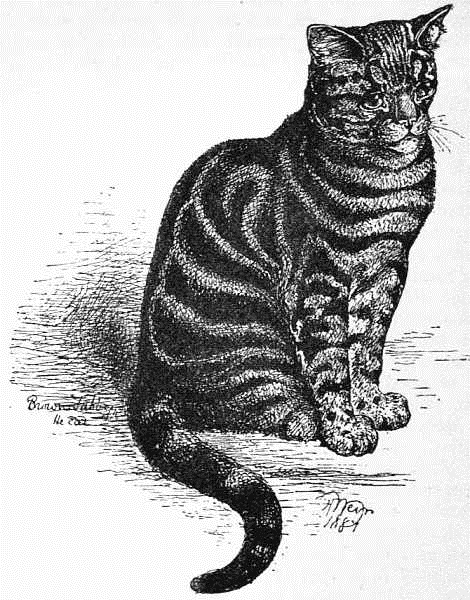
BROWN TABBY—MARKINGS MUCH TOO WIDE.
As I stated in my notes on the Tortoiseshell cat, the best parents to obtain a good brown tabby from is to have a strongly marked, not too broad-banded tabby he-cat and a tortoiseshell she-cat with little black, or red tabby she-cat, the produce being, when tabby, generally of a rich brown, or sometimes what is termed black tabby, and also red tabby. The picture illustrating these notes is from one so bred, and is a particularly handsome specimen. There were two he-cats in the litter, one the dark-brown tabby just mentioned, which I named Aaron, and the other, a very fine red tabby, Moses. This last was even a finer animal than Aaron, being very beautiful in colour and very large in size; but he, alas! like many others, was caught in wires set by poachers, and was found dead. His handsome brother still survives, though no longer my property. The banded red tabby should be marked precisely the same as the brown tabby, only the bands should be of deep red on an orange ground, the deeper in colour the better; almost a chocolate on orange is very fine. The nose deep pink, as also the pads of the feet. The ordinary dark tabby the same way as the brown, and so also the blue or silver, only the ground colour should be of a pale, soft, blue colour—not the slightest tint of brown in it. The clearer, the lighter, and brighter the blue the better, bearing in mind always that the bands should be of a jet black, sharply and very clearly defined.

WELL-MARKED PRIZE SILVER TABBY.
The word tabby was derived from a kind of taffeta, or ribbed silk, which when calendered or what is now termed "watered," is by that process covered with wavy lines. This stuff, in bygone times, was often called "tabby:" hence the cat with lines or markings on its fur was called a "tabby" cat. But it might also, one would suppose, with as much justice, be called a taffety cat, unless the calendering of "taffety" caused it to become "tabby." Certain it is that the word tabby only referred to the marking or stripes, not to the absolute colour, for in "Wit and Drollery" (1682), p. 343, is the following:—
"Her petticoat of satin,Her gown of crimson tabby."Be that as it may, I think there is little doubt that the foregoing was the origin of the term. Yet it was also called the brinded cat, or the brindled cat, also tiger cat, with some the gray cat, graymalkin; but I was rather unprepared to learn that in Norfolk and Suffolk it is called a Cyprus cat. "Why Cyprus cat?" quoth I. "I do not know," said my informant. "All I know is, that such is the case."
So I referred to my Bailey's Dictionary of 1730, and there, "sure enough," was the elucidation; for I found that Cyprus was a kind of cloth made of silk and hair, showing wavy lines on it, and coming from Cyprus; therefore this somewhat strengthens the argument in favour of "taffeta," or "tabby," but it is still curious that the Norfolk and Suffolk people should have adopted a kind of cloth as that representing the markings and colour of the cat, and that of a different name from that in use for the cat—one or more counties calling it a "tabby cat," as regards colour, and the other naming the same as "Cyprus." I take this to be exceedingly interesting. How or when such naming took place I am at present unable to get the least clue, though I think from what I gather from one of the Crystal Palace Cat Show catalogues, that it must have been after 1597, as the excerpt shows that at that time the shape and colour was like a leopard's, which, of course, is spotted, and is always called the spotted leopard. (Since this I have learned that the domestic cat is said to have been brought from Cyprus by merchants, as also was the tortoiseshell. Cyprus is a colour, a sort of reddish-yellow, something like citron; so a Cyprus cat may mean a red or yellow tabby.)
However, I find Holloway, in his "Dictionary of Provincialisms" (1839), gives the following:—
"Calimanco Cat, s. (calimanco, a glossy stuff), a tortoiseshell cat, Norfolk."
Salmon, in "The Compleat English Physician," 1693, p. 326, writing of the cat, says: "It is a neat and cleanly creature, often licking itself to keep it fair and clean, and washing its face with its fore feet; the best are such as of a fair and large kind and of an exquisite tabby color called Cyprus cats."
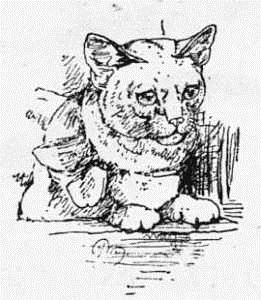
SPOTTED TABBY CAT
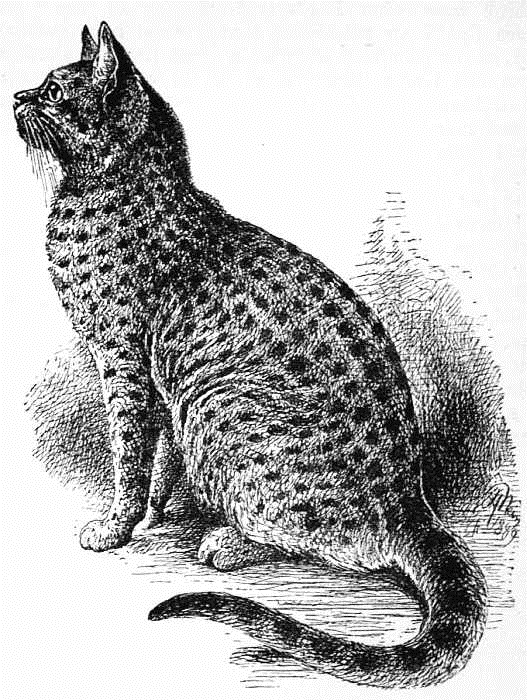
I have thought it best to give two illustrations of the peculiar markings of the spotted tabby, or leopard cat of some, as showing its distinctness from the ordinary and banded Tabby, one of my reasons being that I have, when judging at cat shows, often found excellent specimens of both entered in the "wrong class," thereby losing all chance of a prize, though, if rightly entered, either might very possibly have taken honours. I therefore wish to direct particular attention to the spotted character of the markings of the variety called the "spotted tabby." It will be observed that there are no lines, but what are lines in other tabbies are broken up into a number of spots, and the more these spots prevail, to the exclusion of lines or bands, the better the specimen is considered to be. The varieties of the ground colour or tint on which these markings or spots are placed constitutes the name, such as black-spotted tabby, brown-spotted tabby, and so on, the red-spotted tabby or yellow-spotted tabby in she-cats being by far the most scarce. These should be marked with spots instead of bands, on the same ground colour as the red or yellow-banded tabby cat. In the former the ground colour should be a rich red, with spots of a deep, almost chocolate colour, while that of the yellow tabby may be a deep yellow cream, with yellowish-brown spots. Both are very scarce, and are extremely pretty. Any admixture of white is not allowable in the class for yellow or red tabbies; such exhibit must be put into the class (should there be one, which is usually the case at large shows) for red or yellow and white tabbies. This exhibitors will do well to make a note of.
There is a rich-coloured brown tabby hybrid to be seen at the Zoological Society Gardens in Regent's Park, between the wild cat of Bengal and a tabby she-cat. It is handsome, but very wild. These hybrids, I am told, will breed again with tame variety, or with others.
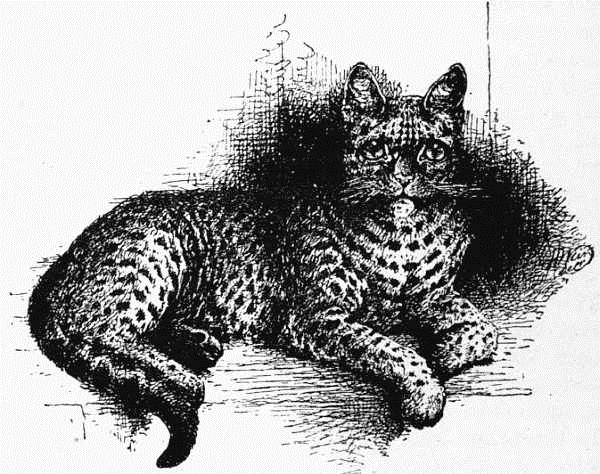
In the brown-spotted tabby, the dark gray-spotted tabby, the black-spotted tabby, the gray or the blue-spotted tabby, the eyes are best yellow or orange tinted, with the less of the green the better. The nose should be of a dark red, edged with black or dark brown, in the dark colours, or somewhat lighter colour in the gray or blue tabbies. The pads of the feet in all instances must be black. In the yellow and the red tabby the nose and the pads of the feet are to be pink. As regards the tail, that should have large spots on the upper and lower sides instead of being annulated, but this is difficult to obtain. It has always occurred to me that the spotted tabby is a much nearer approach to the wild English cat and some other wild cats in the way of colour than the ordinary broad-banded tabby. Those specimens of the crosses, said to be between the wild and domestic cat, that I have seen, have had a tendency to be spotted tabbies. And these crosses were not infrequent in bygone times when the wild cats were more numerous than at present, as is stated to be the case by that reliable authority, Thomas Bewick. In the year 1873, there was a specimen shown at the Crystal Palace Cat Show, and also the last year or two there has been exhibited at the same place a most beautiful hybrid between the East Indian wild cat and the domestic cat. It was shown in the spotted tabby class, and won the first prize. The ground colour was a deep blackish-brown, with well-defined black spots, black pads to the feet, rich in colour, and very strong and powerfully made, and not by any means a sweet temper. It was a he-cat, and though I have made inquiry, I have not been able to ascertain that any progeny has been reared from it, yet I have been informed that such hybrids between the Indian wild cat and the domestic cat breed freely.
THE ABYSSINIAN
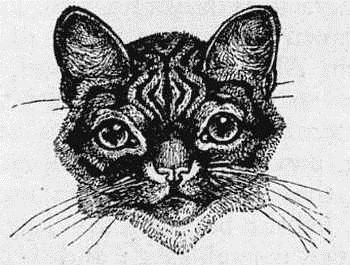
I now come to the last variety of the tabby cat, and this can scarcely be called a tabby proper, as it is nearly destitute of markings, excepting sometimes on the legs and a broad black band along the back. It is mostly of a deep brown, ticked with black, somewhat resembling the back of a wild (only not so gray) rabbit. Along the centre of the back, from the nape of the neck to the tip of the tail, there is a band of black, very slightly interspersed with dark brown hairs. The inner sides of the legs and belly are more of a rufous-orange tint than the body, and are marked in some cases with a few dark patches; but they are best without these marks, and in the exhibition pens it is a point lost. The eyes are deep yellow, tinted with green; nose dark red, black-edged; ears rather small, dark brown, with black edges and tips; the pads of the feet are black. Altogether, it is a pretty and interesting variety. It has been shown under a variety of names, such as Russian, Spanish, Abyssinian, Hare cat, Rabbit cat, and some have gone so far as to maintain that it is a cross between the latter and a cat, proving very unmistakably there is nothing, however absurd or impossible, in animal or everyday life, that some people are not ready to credit and believe. A hybrid between the English wild cat and the domestic much resembles it; and I do not consider it different in any way, with the exception of its colour, from the ordinary tabby cat, from which I have seen kittens and adults bearing almost the same appearance. Some years ago when out rabbit-shooting on the South Downs, not far from Eastbourne, one of our party shot a cat of this colour in a copse not far from the village of Eastdean. He mistook it at first for a rabbit as it dashed into the underwood. It proved not to be wild, but belonged to one of the villagers, and was bred in the village. When the ground colour is light gray or blue, it is generally called chinchilla, to the fur of which animal the coat has a general resemblance. I have but little inclination to place it as a distinct, though often it is of foreign breed; such may be, though ours is merely a variety—and a very interesting one—of the ordinary tabby, with which its form, habits, temper, etc., seem fully to correspond; still several have been imported from Abyssinia all of which were precisely similar, and it is stated that this is the origin of the Egyptian cat that was worshipped so many centuries ago. The mummies of the cats I have seen in no case had any hair left, so that it was impossible to determine what colour they were. The imported cats are of stouter build than the English and less marked. These bred with an English tabby often give a result of nearly black, the back band extending very much down the sides, and the brown ticks almost disappearing, producing a rich and beautiful colouring.
I find there is yet another tint or colour of the tabby proper which I have not mentioned, that is to say, a cat marked with light wavy lines, and an exceedingly pretty one it is. It is very rare; in fact, so much so that it has never had a class appropriated to it, and therefore is only admissible to or likely to win in the class "For Any Other Colour," in which class usually a number of very beautiful varieties are to be found, some of which I shall have occasion to notice further on. The colour, however, that I now refer to is often called the silver tabby, for want of a better name. It is this. The whole of the ground colour is of a most delicate silver-gray, clear and firm in tone, slightly blue if anything apart from the gray, and the markings thereon are but a little darker, with a tinge of lilac in them making the fur to look like an evening sky, rayed with light clouds. The eyes are orange-yellow, and when large and full make a fine contrast to the colour of the fur. The nose is red, edged with a lilac tint, and the pads of the feet and claws are black, or nearly so. The hair is generally very fine, short, and soft. Altogether it is most lovely, and well worthy of attention, forming, as it does, a beautiful contrast to the red, the yellow, or even the brown tabby. A turquoise ribbon about its neck will show to great advantage the delicate lilac tints of its coat, or, if a contrast is preferred, a light orange scarlet, or what is often called geranium colour, will perhaps give a brighter and more pleasing effect.

